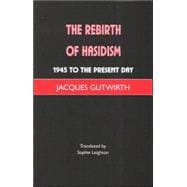
| Introduction | 1 | (3) | |||
| 1. From the Birth to the Rebirth | 4 | (11) | |||
|
4 | (1) | |||
|
5 | (3) | |||
|
8 | (4) | |||
|
12 | (1) | |||
|
12 | (3) | |||
| 2. A European Staging-post: Antwerp | 15 | (12) | |||
|
15 | (1) | |||
|
16 | (1) | |||
|
17 | (2) | |||
|
19 | (3) | |||
|
22 | (5) | |||
| 3. Williamsburg, a Satmar Bastion | 27 | (22) | |||
|
27 | (1) | |||
|
28 | (1) | |||
|
29 | (2) | |||
|
31 | (1) | |||
|
32 | (2) | |||
|
34 | (3) | |||
|
37 | (2) | |||
|
39 | (2) | |||
|
41 | (2) | |||
|
43 | (1) | |||
|
44 | (3) | |||
|
47 | (2) | |||
| 4. Borough Park: a 'Bourgeois District | 49 | (11) | |||
|
49 | (3) | |||
|
52 | (2) | |||
|
54 | (5) | |||
|
59 | (1) | |||
| 5. Crown Heights, Seat of the Lubavitch Movement | 60 | (21) | |||
|
60 | (3) | |||
|
63 | (1) | |||
|
64 | (2) | |||
|
66 | (3) | |||
|
69 | (2) | |||
|
71 | (1) | |||
|
72 | (3) | |||
|
75 | (1) | |||
|
76 | (3) | |||
|
79 | (2) | |||
| 6. Jerusalem | 81 | (21) | |||
|
81 | (1) | |||
|
82 | (2) | |||
|
84 | (1) | |||
|
85 | (4) | |||
|
89 | (2) | |||
|
91 | (1) | |||
|
92 | (1) | |||
|
93 | (1) | |||
|
94 | (1) | |||
|
95 | (1) | |||
|
96 | (2) | |||
|
98 | (1) | |||
|
99 | (1) | |||
|
100 | (2) | |||
| 7. Bene Beraq and Other Locations | 102 | (18) | |||
|
102 | (3) | |||
|
105 | (2) | |||
|
107 | (1) | |||
|
108 | (1) | |||
|
109 | (2) | |||
|
111 | (1) | |||
|
112 | (1) | |||
|
113 | (1) | |||
|
114 | (1) | |||
|
115 | (1) | |||
|
116 | (1) | |||
|
117 | (3) | |||
| 8. Lubavitch in France | 120 | (14) | |||
|
120 | (1) | |||
|
120 | (3) | |||
|
123 | (2) | |||
|
125 | (1) | |||
|
126 | (3) | |||
|
129 | (1) | |||
|
130 | (2) | |||
|
132 | (2) | |||
| 9. Overview | 134 | (19) | |||
|
134 | (1) | |||
|
135 | (2) | |||
|
137 | (1) | |||
|
138 | (3) | |||
|
141 | (1) | |||
|
142 | (3) | |||
|
145 | (2) | |||
|
147 | (3) | |||
|
150 | (3) | |||
| Appendix | 153 | (2) | |||
| Notes | 155 | (23) | |||
| Bibliography | 178 | (9) | |||
| Glossary | 187 | (5) | |||
| Index | 192 |
The New copy of this book will include any supplemental materials advertised. Please check the title of the book to determine if it should include any access cards, study guides, lab manuals, CDs, etc.
The Used, Rental and eBook copies of this book are not guaranteed to include any supplemental materials. Typically, only the book itself is included. This is true even if the title states it includes any access cards, study guides, lab manuals, CDs, etc.